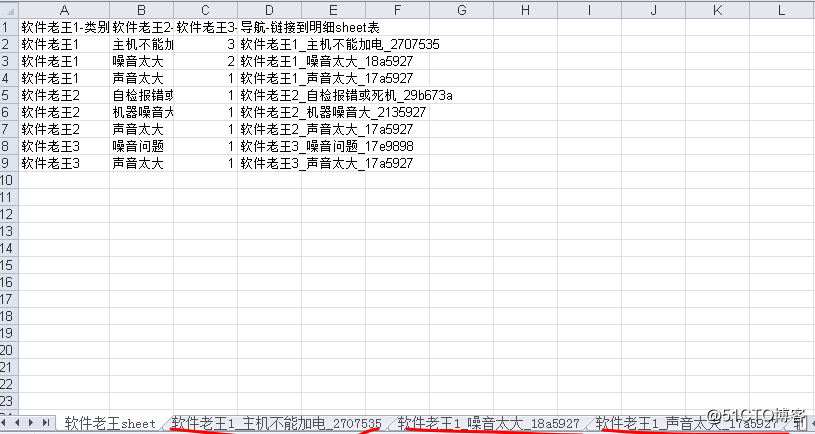文本相似性算法(二)-分组及分句热度统计
2021-03-26 18:24
标签:string 搜索 main 不能 model 干货 reverse 关注 res 软件老王在上一节介绍到相似性热度统计的4个需求,本次介绍分组及分组分句热度统计(需求1和需求2)。 分组热度统计首先根据某列进行分组,然后再对这些句进行热度统计,主要是分组处理,分句仅仅是按照标点符号做了下拆分,在代码说明中可以替换下就可以了。 完整代码,有需要的朋友可以直接拿走,不想看代码介绍的,可以直接拿走执行就行。 以上的代码中有很明确的注释就不再一一介绍了,重点说几个。 (1)分组处理跟文本相似性热度统计算法实现(一)-整句热度统计相似,不同的是首先按照某一列做了分组处理,然后进行相似性统计,相似性这块一样,其实不同的主要是excel处理这块的内容。 (2)excle分组用的是pandas包,python中excel数据分组处理。 (3)关于需求2,分组分句,代码如下: 2.3 效果图 (1)软件老王-source2.xlsx (2)软件老王-target2.xls (3)简单说明 从数据中可以看出来,例如:声音太大,分属三类,首先分类,然后再比对相似性。 欢迎关注公众号「软件老王」,IT技术与相关干货分享,回复关键字获取对应干货,java,送必看的10本“武功秘籍”;图片,送100多万张可商用高清图片;面试,送月薪“20k”的java面试题等。 文本相似性算法(二)-分组及分句热度统计 标签:string 搜索 main 不能 model 干货 reverse 关注 res 原文地址:https://blog.51cto.com/14130291/25347822. 解决方案
2.1 完整代码
import jieba.posseg as pseg
import jieba.analyse
import xlwt # 写入Excel表的库
import pandas as pd
from gensim import corpora, models, similarities
import re
#停词函数
def StopWordsList(filepath):
wlst = [w.strip() for w in open(filepath, ‘r‘, encoding=‘utf8‘).readlines()]
return wlst
def str_to_hex(s):
return ‘‘.join([hex(ord(c)).replace(‘0x‘, ‘‘) for c in s])
# jieba分词
def seg_sentence(sentence, stop_words):
stop_flag = [‘x‘, ‘c‘, ‘u‘, ‘d‘, ‘p‘, ‘t‘, ‘uj‘, ‘f‘, ‘r‘]
sentence_seged = pseg.cut(sentence)
outstr = []
for word, flag in sentence_seged:
if word not in stop_words and flag not in stop_flag:
outstr.append(word)
return outstr
if __name__ == ‘__main__‘:
# 1 这些是jieba分词的自定义词典,软件老王这里添加的格式行业术语,格式就是文档,一列一个词一行就行了,
# 这个几个词典软件老王就不上传了,可注释掉。
jieba.load_userdict("g1.txt")
jieba.load_userdict("g2.txt")
jieba.load_userdict("g3.txt")
# 2 停用词,简单理解就是这次词不分割,这个软件老王找的网上通用的。
spPath = ‘stop.txt‘
stop_words = StopWordsList(spPath)
# 3 excel处理
wbk = xlwt.Workbook(encoding=‘ascii‘)
sheet = wbk.add_sheet("软件老王sheet") # sheet名称
sheet.write(0, 0, ‘软件老王1-类别‘)
sheet.write(0, 1, ‘软件老王2-原因‘)
sheet.write(0, 2, ‘软件老王3-统计数量‘)
sheet.write(0, 3, ‘导航-链接到明细sheet表‘)
inputfile = ‘软件老王-source2.xlsx‘
data = pd.read_excel(inputfile) # 读取数据
grp1 = data.groupby(‘类别‘)
rcount = 1
for name, group in grp1:
print(grp1)
texts = []
orig_txt = []
key_list = []
name_list = []
sheet_list = []
name = name.replace(‘\n‘, ‘‘).replace(‘/‘, ‘‘)
for i in range(len(group)):
row = group.iloc[i].values
cell = row[1]
if cell is None:
continue
if not isinstance(cell, str):
continue
item = cell.strip(‘\n\r‘).split(‘\t‘)
string = item[0]
if string is None or len(string) == 0:
continue
else:
textstr = seg_sentence(string, stop_words)
texts.append(textstr)
orig_txt.append(string)
# 4 相似性处理
dictionary = corpora.Dictionary(texts)
feature_cnt = len(dictionary.token2id.keys())
corpus = [dictionary.doc2bow(text) for text in texts]
tfidf = models.LsiModel(corpus)
index = similarities.SparseMatrixSimilarity(tfidf[corpus], num_features=feature_cnt)
result_lt = []
word_dict = {}
count =0
for keyword in orig_txt:
count = count+1
print(‘开始执行,第‘+ str(count)+‘行‘)
if keyword in result_lt or keyword is None or len(keyword) == 0:
continue
kw_vector = dictionary.doc2bow(seg_sentence(keyword, stop_words))
sim = index[tfidf[kw_vector]]
result_list = []
for i in range(len(sim)):
if sim[i] > 0.5:
if orig_txt[i] in result_lt and orig_txt[i] not in result_list:
continue
result_list.append(orig_txt[i])
result_lt.append(orig_txt[i])
if len(result_list) >0:
word_dict[keyword] = len(result_list)
if len(result_list) >= 1:
name = name.strip(‘\n\r‘).replace(‘\n‘, ‘‘).replace(‘/‘, ‘‘).replace(‘,‘, ‘‘).replace(‘。‘, ‘‘).replace(
‘*‘, ‘‘)
name = re.sub(u"([^\u4e00-\u9fa5\u0030-\u0039\u0041-\u005a\u0061-\u007a])", "", name)
sname = name[0:10] + ‘_‘ + re.sub(u"([^\u4e00-\u9fa5\u0030-\u0039\u0041-\u005a\u0061-\u007a])", "", keyword[0:10])+ ‘_‘ + str(len(result_list)+ len(str_to_hex(keyword))) + str_to_hex(keyword)[-5:]
sheet_t = wbk.add_sheet(sname) # Excel单元格名字
for i in range(len(result_list)):
sheet_t.write(i, 0, label=result_list[i])
# 5 按照热度排序 -软件老王
with open("rjlw.txt", ‘w‘, encoding=‘utf-8‘) as wf2: # 打开文件
orderList = list(word_dict.values())
orderList.sort(reverse=True)
count = len(orderList)
for i in range(count):
for key in word_dict:
if word_dict[key] == orderList[i]:
key_list.append(key)
name_list.append(name)
word_dict[key] = 0
wf2.truncate()
# 6 写入目标excel
for i in range(len(key_list)):
sheet.write(i+rcount, 0, label=name_list[i])
sheet.write(i+rcount, 1, label=key_list[i])
sheet.write(i+rcount, 2, label=orderList[i])
if orderList[i] >= 1:
shname = name_list[i][0:10] + ‘_‘ + re.sub(u"([^\u4e00-\u9fa5\u0030-\u0039\u0041-\u005a\u0061-\u007a])", "", key_list[i][0:10]) + ‘_‘+ str(orderList[i]+ len(str_to_hex(key_list[i])))+ str_to_hex(key_list[i])[-5:]
link = ‘HYPERLINK("#%s!A1";"%s")‘ % (shname, shname)
sheet.write(i+rcount, 3, xlwt.Formula(link))
rcount = rcount + len(key_list)
key_list = []
name_list = []
orderList = []
texts = []
orig_txt = []
sheet_list =[]
wbk.save(‘软件老王-target2.xls‘) 2.2 代码说明
如果你觉得文章对你有些帮助,欢迎微信搜索「软件老王」第一时间阅读或交流! for i in range(len(group)):
row = group.iloc[i].values
cell = row[1]
if cell is None:
continue
if not isinstance(cell, str):
continue
item = cell.strip(‘\n\r‘).split(‘\t‘)
string = item[0]
#软件老王,这里按照标点符号对原因进行拆分,然后再进行处理。
lt = re.split(‘,|。|!|?‘, string)
for t in lt:
if t is None or t.strip() == ‘‘ or len(t.strip()) == 0:
continue
else:
textstr = seg_sentence(t, stop_words)
texts.append(textstr)
orig_txt.append(t)
类别
原因
软件老王1
主机不能加电
软件老王1
有时不能加电
软件老王1
开机加电
软件老王2
自检报错或死机
软件老王2
机器噪音大
软件老王3
噪音问题
软件老王1
噪音太大
软件老王1
噪音噪声
软件老王1
声音太大
软件老王2
声音太大
软件老王3
声音太大
软件老王1-类别
软件老王2-原因
软件老王3-统计数量
导航-链接到明细sheet表
软件老王1
主机不能加电
3
软件老王1_主机不能加电_2707535
软件老王1
噪音太大
2
软件老王1_噪音太大_18a5927
软件老王1
声音太大
1
软件老王1_声音太大_17a5927
软件老王2
自检报错或死机
1
软件老王2_自检报错或死机_29b673a
软件老王2
机器噪音大
1
软件老王2_机器噪音大_2135927
软件老王2
声音太大
1
软件老王2_声音太大_17a5927
软件老王3
噪音问题
1
软件老王3_噪音问题_17e9898
软件老王3
声音太大
1
软件老王3_声音太大_17a5927


上一篇:window界面控制